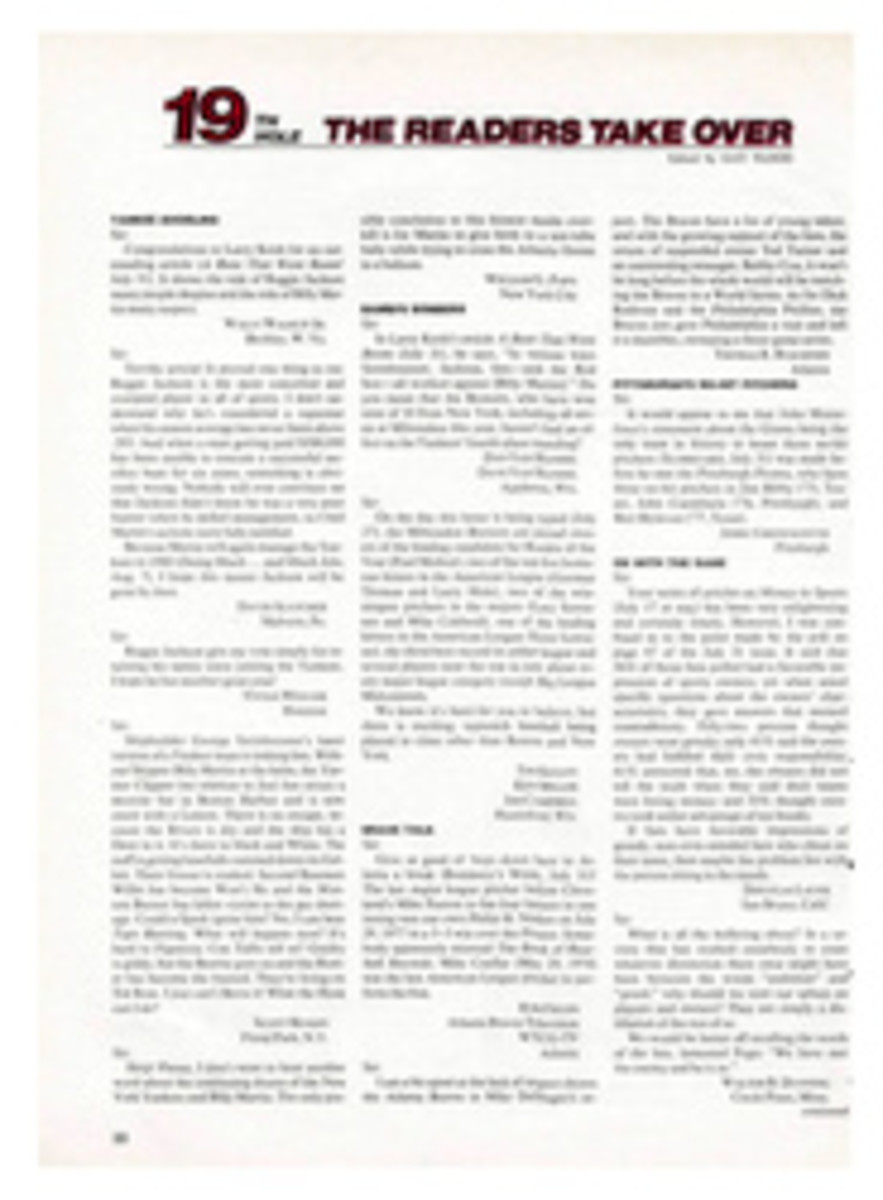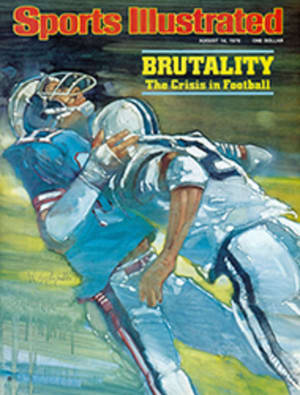
TAKING THE RIGHT TURN ON A COOK'S TOUR
There are 56 different rides in the vast amusement park on the shore of Lake Erie at Cedar Point, Ohio. Some of them are novel, but the best are traditional. Cedar Point has two Dodgems, where customers can play chicken with their friends. On Gemini, the biggest of the park's six roller coasters, the riders swoop back and forth between inner and outer space at more than 60 mph while their stomachs press hard against their brains, and vice versa. Ergo, Cedar Point is a fit and proper place for offshore powerboat racers to gather.
The most important differences between the rides at Cedar Point and the Grand National offshore boat race held there every August are both mechanical and fiscal. The park's Ferris wheel, old-timey choo-choo trains, cable and Dodgem cars rarely break down. The $50,000 offshore powerboats very often do. Admission to the park is $8.75 for adults, all rides included. Just how many rides a person cares to try depends largely on how long he wants to retain his last meal. In contrast, to get crew and boat and back-up gear and sponsor and sponsor's high-living friends to one Grand National offshore race, a driver or owner forks out up to $15,000. At that rate just how long the competitors stay in offshore competition depends on how much they enjoy a gambling game where the first-place purse—$10,375 at Cedar Point—barely covers the cost of getting to the next race.
As offshore boats have become lighter and faster, the attrition rate has climbed dramatically. Two years ago, 63% of the entries on the 10-race circuit finished. In five races to date this sear son, only 45% of the starters have made it all the way. Until this year, the Cedar Point Grand National course used to reach 52 miles easterly to the near side of Cleveland, then back and around a group of large and small islands, each inhabited by a different tribe of gremlins. Because Lake Erie is shallow—quickly spawning steep waves in a blow—the course was changed last Saturday, the long leg to Cleveland being eliminated. After a short dash eastward, the 177.5-mile course zigged twice around the islands. As if that were not tricky enough, the Coast Guard reminded the racers that the fishing was better than it had been in years. In certain areas of the course, the Coast Guard had counted up to 5,000 fishing boats on weekends. Furthermore, there was the possibility that commercial fishermen were sneakily laying nets in restricted areas where they should not. And as a final threat, there was to be an offshore sailboat race with a fleet of 70; if the air was light the fleet would be strung out over one of the legs of the powerboat course.
There were indeed fishing boats galore, but none got seriously in the way. And a five-knot east wind blew the sailing fleet safely across the leg before the offshore boats howled along it. No misplaced fishnets were encountered, but there was trouble aplenty without them. Eighteen open-class boats started; only eight were alive on the course two hours later. The non-finishers suffered a variety of afflictions.
Billy Martin, who has been in the game the longest—eight topsy-turvy years—previewed the Cedar Point race with his usual jolly pessimism. "We have bigger boats now that can run faster longer. We don't have to keep backing off" the throttles as much; we can get on top of the waves more often and run across the top of them. If the water is flat for the race, you're going to see a big scrap pile of engine parts. If it gets rough, you'll see a pile of broken hulls. It'll be either burned-up motors or beat-up boats."
Although Martin has never been overwhelmed by good luck (his special grief over the years has been to finish first and get, instead of the checkered flag, a disqualification for a course infraction), the first veteran to be struck down in the Cedar Point race was Sandy Satullo, a local hero from Cleveland, who had won the last two Cedar Point races. Satullo came out of retirement to defend his title in a borrowed boat. "I know the boat I am driving is blue and white," he said on the eve of the race. "I know it is 39 feet long, and I know it has the number '83' on the side. I know that much because the owner told me on the phone." Satullo did not get to know the borrowed boat much better. Ten minutes after the start the engine block cracked.
If not the duty, it is then at least the pleasure of gremlins not only to humiliate champions but also to trample on the already downtrodden. The second pilot to drop out was Rocky Aoki, the restaurateur who sponsors two races on the circuit. Having failed to finish in the first four races of the season, Aoki should have been due for at least a complete tour of the circuit, but just after he had completed the first trip around those pesky islands, a bolt in his transmission let go.
After Aoki, what better victim could there be than Joel Halpern, who has won two consecutive national titles? If not Halpern, how about Betty Cook, the only woman in the game? Cook, who is in her fourth year of racing, won the 1977 world championship in the final race of the season at Key West last November. Before the Cedar Point race, she said, "I want a rough-water race. We have a heavy boat at about 8,000 pounds. The rougher it is, the better we will do. John Connor, my mechanic, is great and Don Holloway, my navigator, is super in rough water, when the compass card is bouncing all around."
The seas on race day barely exceeded a foot, far better suited to lighter boats than the tunnel hull driven by Halpern. But Holloway proved, if not super, at least superior at a critical early moment that kept his team very much in the game. As Halpern led the pack toward the easternmost checkpoint, for a deluding instant it looked as if the gremlins had reached out from their distant islands to fetch Cook a wallop. Actually it was Halpern they were out to get. When challenged for the lead by Arnold Glass, an Australian who had lost his way, Halpern unwittingly let himself be carried off course—and was chased by three other boats foolishly playing follow-the-leader. Holloway, the super navigator, was the first to note that everybody was boiling along low of the mark. Because of his quick correction, within a minute Cook had moved her 38-foot Scarab from a quarter mile behind Halpern to a quarter mile ahead of everybody. Halpern, the leader led astray, rounded the mark fifth. Glass, the wandering Aussie, got around 16th.
Because of his flat-water hull, Halpern slowly made up what he had lost. He deliberately did not try to close the gap too quickly because after four races he was trailing Cook, the season's leader, by 485 points. Winning 400 points for the first place, to her 300 for second, would gain him little. But by applying pressure through the race, he might force her to break down, thereby making a clean gain of 400 points. But then, after one trip around the islands, it was Halpern who conked out, the transmission bell housing breaking.
Billy Martin still had a solid chance of catching Cook, but it was not to be: a broken rod and leaking oil stopped him cold early on the second circuit of the islands. In the final 20 miles one last challenger, Preston Henn, had a run at Cook but she won with 200 yards to spare.
By all rights, the winningest combination in a hyper-technical game like offshore powerboat racing should be a veteran driver and crew with the latest red-hot equipment, but such logic is too pat for this whimsical pursuit. Sometimes old hands win in new boats, and sometimes novices win in junk stuff. The third driver to finish at Cedar Point was a rookie, Al Weichelsbaum in the latest kind of Cigarette hull. The fourth to finish was Jerry Jacoby, another rookie, driving a fourth-hand Cigarette that has been to the wars too often. Two years ago, Tom Gentry won the world championship in Jacoby's hull. Last year, when Joe Ippolito, who came in sixth at Cedar Point, drove the same hull in the world championship it literally came apart. There is no figuring the luck of offshore racing, even when it is practiced inland. It is the sweet prospect of winning, or even finishing where so many others fail, that keeps the racers coming.
TWO PHOTOS
Leading the inland-offshore pack home, Cook wound up with the trophy—in this case, full of beer.

